

25th November 2024 (10 Topics)
Context
Increasing pollution is causing damage to people’s lungs. Even teenagers’ lungs are now resembling those of lifelong smokers, a stark sign of the widespread harm from urban pollution.
Pollution as a National Health Crisis
- According to the United Nations Environment Programme (UNEP), pollution levels are rising quickly in India, with emissions increasing by more than 6% from the previous year.
- Air pollution is now the leading environmental cause of premature death in India. In 2021, nearly 2 million deaths were attributed to pollution-related health issues.
- Vulnerable groups like pregnant women, children, the elderly, and those with pre-existing health conditions are most affected by air pollution, which increases the risk of respiratory infections, heart diseases, and other health complications.
- Impact on Children’s Health: Air pollution is severely affecting children's lung development, leading to chronic conditions like asthma. These aren't just temporary issues; they can result in lifelong health problems.
Impact of Air Pollution on Specific Organs
Air pollution affects several key bodily systems and organs, contributing to a wide range of health problems:
- Respiratory System
-
- Asthma & Allergic Rhinitis: Pollutants aggravate respiratory conditions like asthma and allergic rhinitis (hay fever), leading to more frequent attacks and worsening symptoms.
- Chronic Obstructive Pulmonary Disease (COPD): Long-term exposure to air pollution can damage the lungs, leading to COPD, a group of diseases that obstruct airflow and make breathing difficult.
- Lung Cancer: Pollutants, especially carcinogens in the air, increase the risk of lung cancer.
- Pneumonia & Lung Infections: Air pollution can also increase susceptibility to acute respiratory infections like pneumonia, particularly in vulnerable groups such as the elderly and children.
- Cardiovascular System
-
- Heart Disease: Fine particulate matter (PM2.5) in the air is linked to heart disease, including an increased risk of heart attacks, strokes, and heart failure.
- Hypertension: Long-term exposure to air pollution can cause high blood pressure (hypertension), a leading risk factor for cardiovascular diseases.
-
- Cognitive Decline & Dementia: Air pollution is also associated with cognitive impairments, including early cognitive decline, dementia, and Alzheimer’s disease. Pollutants can negatively affect brain function, accelerating the onset of neurological diseases.
- Skin
-
- Dermatitis & Eczema: Pollution can lead to skin conditions such as dermatitis and eczema, causing redness, irritation, and inflammation.
- Premature Skin Aging: Exposure to pollutants accelerates the aging process of the skin, leading to wrinkles, loss of elasticity, and pigmentation changes.
- Internal Organs
-
- Kidney & Liver Damage: Air pollution can also affect internal organs like the kidneys and liver, potentially leading to chronic kidney disease and liver dysfunction. The toxins in polluted air may cause inflammation and damage to these vital organs.
Main Pollutants
|
More Articles


